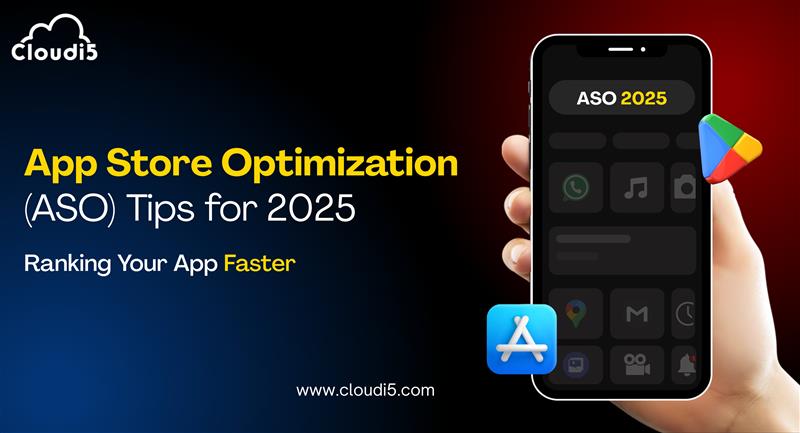
App Store Optimisation (ASO) Tips For 2025: Ranking Your App Faster
Making an app is great, but getting it known is even better. This is where the real action begins. Let us discuss ASO magic for 2025.
What is App Store Optimization (ASO)?
App Store Optimization (ASO) is the process of improving your mobile app's visibility in app stores such as the Apple App Store and Google Play Store. It's similar to SEO (Search Engine Optimisation), but instead of websites ranking on Google, it's apps that rank in app store search results. For Example, when someone searches for an app, like “fitness tracker” or “budget planner,” ASO helps your app appear higher in those results.
To stay ahead in ASO, it’s important to understand how AI is transforming the future of mobile app development. This is especially true in areas like personalised recommendations, predictive analytics, and smarter user targeting. App stores now use AI to decide which apps to display first, based on keywords, visuals, and user behaviour.
Without appropriate ASO, even outstanding apps can go unnoticed and miss out on downloads. ASO enables ranking apps faster, be noticed easily, and expand naturally. It's the most effective approach to compete in a crowded app market powered by AI.
This blog offers simple techniques to improve your app's ranking and get more downloads.
Why ASO Still Matters in 2025?
In 2025, creating an app is just the start. Getting it discovered is where the real value lies. With millions of apps out there, App Store Optimization (ASO) helps the right people discover yours. Today’s app stores aren’t just about keywords, their smarter algorithms look at your app’s overall story, how often it’s updated, how users interact with it, and what reviews say. ASO helps your app get noticed by real users searching for something like it. When you're getting started with ASO in 2025, don’t overthink it. Just focus on the kind of longer search terms people actually use.
Understanding Keyword Strategy with 2025 Tools:
One clever solution to get your ASO strategy in motion is through targeting long-tail keywords in 2025. They are longer, particular phrases that individuals make use of in the process of searching. They tend to be less competitive and to attract the type of user that is needed. Keyword optimization for app growth will be easier in 2025 with tools that recommend the best terms based on what users want and current trends.
Since app stores can now understand meaning through semantic search, natural language with context is rated higher than exact matches. Apps that sound relevant and human perform better than those that overuse keywords. Keyword optimization for app listings also helps improve your ranking in search results and category charts. Localization are important too. If you take the time to translate your keywords into local languages, it really helps. People in other countries are way more likely to find your app that way and actually download it.
To build a strong ASO strategy for 2025, selecting the appropriate tools is equally important as picking the appropriate keywords.
Here are some of the trending ASO Tools:
- AppTweak- helps you find the best keywords with AI, see what your competitors are doing, and track your app’s performance in real time.
- App Radar- It allows you to research keywords and directly improve your app store listings from a single dashboard, which saves time and effort.
- Mobile Action- It provides detailed keyword insights, assists with localisation, and displays how your app stacks up against others in your niche.
- Sensor Tower- Great for spotting market trends, tracking keyword rankings, and measuring your app's visibility and performance.
In 2025, placing keywords naturally requires balance. You should include your main keyword in the app title to improve visibility. Supporting keywords can go in the subtitle for added context. When writing your app’s description, make sure the keywords blend in naturally. When you're writing your app’s description, just try to keep it simple and natural. Use keywords in a way that makes sense—like how you’d say things out loud. Try not to add too many keywords as it just makes things harder to read. What really matters is keeping it simple so people actually get what your app does and why it’s worth their time.
Converting Creatives: Videos, Screenshots, and Icons:
In 2025 app visuals are the first impression they have to make count. Simple clear and on benefits for the user design. Test your icons and screenshots through A/B testing with tools like Google Play Experiments or SplitMetrics to find out what leads to more installs. For videos, the first 5 seconds matter most; immediately showcase your app’s value. Fast, engaging preview videos that focus on benefits can significantly improve conversion rates. High-quality icons, pictures, and sample videos play an important role in moulding first impressions and can greatly increase app visibility in crowded app stores.
Strong visuals aren’t just eye-catching. Above all, they do make the difference. You keep testing, iterating, keep thinking about what your users want and eventually you can make views into actual installs.
Ratings, reviews, and retention significantly influence your app’s visibility and ranking. App stores like Google Play and Apple App Store rely on these factors to assess app quality and user satisfaction. A positive feedback is an indication of value. Conversely, poor reviews, or low retention may be detrimental to the visibility of your app.
Retention indicates how many users continue to use your app after installing it. If users uninstall quickly, it suggests a bad experience. However, regular use shows app stores that your app is valuable; this improves your ranking. Bear in mind that high-quality images draw attention and they have a direct influence on your apps install rates and reviews.
Here are some of the strategies for boosting reviews:
- Ask at the right time- Show a review prompt after a user finishes a task or has a good experience.
- Keep it simple- Use short, friendly messages when you ask for reviews.
- Avoid interrupting- Don’t ask for reviews too early or during important tasks.
- Use post-task prompts- Trigger review requests right after a successful action, like placing an order or finishing a level.
- Make it easy to review- One tap should take users to the review screen.
Solutions like AppFollow help users stay on top of their app reviews from all sources, while AI-based sentiment analysis technology helps you determine whether users are happy or mad quickly. By returning to the user's sentiment feedback loop quicker, you can make the app experiences better.
To improve experiences and minimize uninstalls, consider these quick tips:
- Fast load times: Have a fast load time on the start of the app and within the app.
- Easy interface: Make sure your interface is not cluttered, simple, and intuitive.
- Fix bugs quickly: Update the app quickly and often to fix crashes and bugs.
- Limit ads: Don't put too many pop-ups or distracting ads in apps.
- Provide value early: Try to clearly convey (and prove) the value the app provides in the initial few uses of the app.
Future-Proofing Your ASO Strategy:
Your ASO strategy for 2025 needs to adjust to new trends such as voice search, AI-powered recommendations, and personalised app listings. It’s no longer just about inserting keywords. It’s important to create a complete user experience. This means using strong images, writing good descriptions, and ensuring you are instilling value from the very start.
App ranking factors are important to be familiar with since they impact visibility. For example, stores like Google Play and the App Store usually consider factors like keywords, ratings, reviews, retention, how often you update, and even how fast people download your app. Working on these areas helps your app rank higher and attract more users.
By following ASO best practices such as adding natural keywords in titles and descriptions, testing icons and screenshots regularly, and tracking your analytics. Keep up-to-date with regular updates, listen to user feedback, and adapt your model based on performance assessment. That way your app remains relevant, easy to discover and ready for what’s next.
Conclusion:
By 2025, key words crammed to the rafters and more are simply not enough to make an app stand out in an entire market full of other apps. Being aware of the major app ranking factors, such as ratings, retention, keyword relevancy, and user retention, you can modify your strategy in order to perform better. Following proven ASO best practices, such as optimizing visuals and descriptions, running A/B tests, and tracking analytics, ensures your app not only ranks higher but also provides a great user experience. Stay updated, keep testing, and your app will be ready to climb the charts faster and more effectively.
To explore expert solutions in mobile app development, check out Cloudi5 Technologies.
Trusted By












Leave Comments